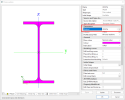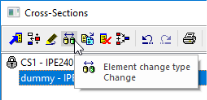Model dummy elements
A dummy element is a fictive element that can be a helpful tool for certain modelling issues, for example: connecting two eccentric beams, connecting an eccentric beam to a plate, connection between two plates, etc.
A 1D dummy element can be made with these three simple steps:
- Create a fictive material: to create a fictive material, you can copy a material that is already available in the 'Material' library. You will need to change the unit mass to a lower value: 0.1 kg/m³. Do not set this parameter to 0 kg/m³, this could lead to some numerical issues in the calculation. Also increase the E modulus with a factor 100.
- Create a fictive element: the next step is to create a fictive element. Open the Cross-sections library and input a new cross-section with the fictive material.
-
Optional: change type to numerical. Finally, if necessary, the type of the cross-section can be changed to 'numerical' in the cross-section library. This can be done to make the dummy element ‘invisible’ when rendering the model.
A 2D dummy element can be modelled by creating a fictive material and using this material in a 2D element:



